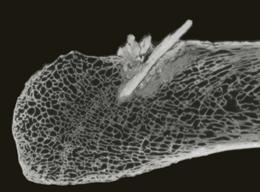Please note: The Academy will close at 3 pm on Thursday, April 18, for Big Bang Gala.
Science News
Historic Mastodon Hunt
October 24, 2011

As the saying goes, timing is everything. And in the case of a fossilized mastodon rib, that certainly seems to be true.
Thirty years ago, a farmer discovered an adult male mastodon skeleton in Washington state. At the time, archeologist Carl Gustafson excavated the fossil and found some peculiar things about it. Ed Yong explains in the Guardian:
[He] noticed a pointed object embedded in its rib. Gustafson took a fuzzy x-ray and interpreted the object as a projectile point made of bone or antler… By dating organic matter around the fossil, he estimated that it was about 14,000 years old.
Other researchers challenged the man-made instrument and date—one reason was that it pre-dated the Clovis culture by about 1,000 years. Clovis is the name given to the distinctive tools made by people starting around 13,000 years ago. Gustafson’s finding would have rewritten the history of people on our continent.
Technology has changed quite a bit since the discovery of the mastodon bone thirty years ago. Enter Michael Waters of Texas A&M. As we described in an article about his research last spring, he’s not afraid to rewrite history. Waters contacted Gustafson about performing new tests on the rib with the bone point.
Waters modern tests confirmed Gustafson’s suspicions. New radiocarbon dates confirmed that the site was 13,800 years old. High resolution CT scanning and three-dimensional modeling confirmed that the embedded bone was a spear point, and DNA and bone protein analysis showed that the bone point was made of—get this—mastodon bone.
“The evidence from the site shows that people were hunting mastodons with bone weapons before the Clovis stone spear point,” says Waters.
In addition, the new evidence supports extinction theories of large mammals at the end of the last Ice Age. During the last cold period, herds of mammoth, mastodon, camels, horses and other animals roamed Texas and North America. At the end of the Ice Age, these animals became extinct.
“While these animals were stressed by the changing climate and vegetation patterns at the end of the Ice Age, it is now clear from sites like [this one] that humans were also hunting these animals and may have been a factor in their demise,” Waters adds.
Timing is indeed everything. The current research was published last week in the journal Science.
Image courtesy of Center for the Study of the First Americans, Texas A&M University